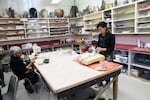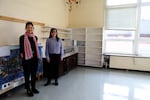In February 2018, Portland City Council voted unanimously to accept an ambitious plan to preserve the city's creative spaces.
Artists are far from the only people affected by rising residential and commercial real estate prices, but they’re also part of the city’s cultural identity. Leaders including Mayor Ted Wheeler, Commissioners Nick Fish and Chloe Eudaly (herself a former bookstore owner) pledged to support an effort to preserve creative spaces. All items on the list were designed to be revenue-neutral, requiring no new city funding.
It's been a year since the plan went into action. So what has happened? We break it down.

Portland is home to amazing arts and cultural resources, like the Multnomah Arts Center, which offers classes and community resources for a variety of disciplines, including visual art, music, and dance. But many parts of town, including the east side, remain under-resourced, and artists in all quadrants are coping with soaring real estate rates.
April Baer / OPB
What Got Done:
Some core staff across seven city bureaus and several council offices brought a half-dozen points to fruition. Among them:
- The Interstate Firehouse Cultural Center: Sited in a historically-black neighborhood in North Portland, IFCC stood mostly empty for several years. It's run by Portland Parks and Recreation. Parks has turned to a group of community stakeholders to help develop a new plan for IFCC. In the meantime, it's leasing out IFCC for arts events at below-market rates, with a preference for African-American arts groups. The city hopes to replicate the model with other culturally-specific groups in other parts of town that might be interested in different Parks properties.
- Portland Parks is making lighting and sound upgrades in facilities at some community centers, in hopes of making them suitable for performances and other events.
- The Bureau of Development Services has four new specialists empowered to work with small businesses — among them, arts and cultural groups — to smooth some of the bumps in the permitting process. City permits for building and occupancy can be a rabbit warren of code rules and arcane appeals processes. Officials like Eudaly are optimistic the staffing will give small nonprofits and individuals a place to go if they're trying to get a live/work space to code, add a stage or other amenities.
What’s Left To Do
The plan also detailed a number of ideas that didn’t come to pass.
- A real estate bank for arts and creative space: Some Portlanders have become keenly interested in the Bay Community Arts Stabilization Trust. A sort of land bank for arts nonprofits, it works intensively with groups that need a building, helping them build capacity and encouraging them to find the donors they need to make a big capital investment work. Wonky stuff, but it's a holy grail for many arts groups tossed from one leased space to another.
- Incentives for landlords to build galleries and studios in new construction.
- One recommendation called for the city to encourage colleges and hospitals to increase their exhibition space. On the higher education front, the exact opposite has happened. Marylhurst University is closed and its Art Gym is headed for Portland Art Museum. It's a partial save: the exhibitions and publications will continue, but most days you'll have to pay to see them. Lewis and Clark is restricting its Hoffman Gallery to student work. And Oregon College of Art and Craft — with its gallery — is closing in May.
Six of the plan's recommendations are either in limbo or in the planning stage, including:
- A Regional Arts and Culture Council plan to map the city's creative resources. That's a critical step for the city to identify dry spots for the arts and prioritize future plans.
- Prosper Portland is in early-stage planning for offering some below-market-rate leases to creatives at Union Station, in coordination with city staff.
- The city's 2% For Art program is being retooled to allow some different uses.
And there’ve been a number of promising developments that were not part of the plan.

Soo Pak (left), is Arts, Culture, and Special Events Manager for Portland Parks and Recreation. Tracy Schreiber (right) is an Arts Affordability Fellow in the office of Commissioner Nick Fish. They're among a handful of city staffers who've spent the past year doing their best to make the Creative Space Preservation plan happen.
April Baer / OPB
- Outside of RACC, the bureau that seems to be doing the most for art right now is Portland Parks and Recreation. Under the direction of Soo Pak, the bureau's arts, culture, and special events manager, Parks is opening up below-market leases at the Multnomah Arts Center, plus some grants for space MAC, the Laurelhurst Dance Studio, and Charles Jordan Community Center for artists and art groups willing to do some community engagement. Pak has a slew of deliverables under her belt, and a to-do list a mile long, but she isn't flinching.
- The Parks Bureau is also taking on a survey of artists' needs, to see if there might be other ways the bureau can help.
- Portland's Bureau of Transportation is working on a long-sought pilot program that will allow musicians to use the loading zones in front of 12 venues to load and unload their gear. The newly-formed advocacy group MusicPortland pushed hard for this one.
Eudaly is in charge of the city's arts portfolio. While Eudaly clearly has her eyes on the macro real estate issues that have driven homelessness and gentrification — everybody knows those are the priorities — Eudaly also told us that she's never lost sight of the arts-specific real estate issues.
"I would like to start by saying this is the conversation I've been wanting the city to have for more than a decade," Eudaly told us.
She talked about the rent control bill that passed in Salem last month.
Related: Rent Control Is Now The Law In Oregon
"You might be hearing getting a more grim picture than we are. I think being in a position of influence and having an ability to do anything makes me a somewhat more hopeful person than perhaps a journalist focused on arts and culture, or an artist trying to ride out this seemingly never-ending housing and affordability crisis."
She points to the new staff at BDS and RACC's mapping project as hopeful signs for the next stages of arts preservation.
While the Creative Space plan was not completed in a year, it may be those 24 points can serve as a roadmap as the city moves forward.
